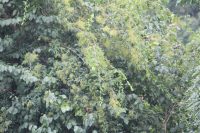|
Sageretia filiformis (Roth) G. Don, Gen. Hist. 2: 29 1832. (syn: Berchemia oppositifolia Wall.; Berchemia parviflora Wall.; Rhamnus filiformis Roth ex Schult.; Rhamnus parviflorus Klein ex Schult.; Rhamnus terminalis Buch.-Ham. ex D. Don; Rhamnus trigynus D. Don; Sageretia blumii G. Don; Sageretia oppositifolia (Wall.) Brongn.; Sageretia parviflora (Klein ex Willd.) G. Don; Sageretia trigyna G. Don.; Ziziphus oppositifolia Wall.);
.
Bhutan, India (Himachal Pradesh, Uttar Pradesh, Bihar, West Bengal, Assam, Orissa, Maharashtra, Andhra Pradesh, Karnataka, Tamil Nadu), Malaysia, Java,
Myanmar [Burma] (Kachin, Mandalay, Sagaing), Nepal, Pakistan (Jhelum), Pakistani Kashmir (Mirpur), Jammu & Kashmir (Jammu) as per Catalogue of Life ; .
Climbing shrub with long arching slender shoots and axillary spines on main stems; branchlets softly pubescent. Leaves rigid, ovate or ovate-lanceolate, 5-10 x 2.3-5.5cm, acuminate, base rounded or weakly cordate, margin serrulate, villous when yong becoming almost glabrous, glossy above, lateral veins 5-7 pairs, prominent beneath; petioles 5-13 mm; stipules linear, 1-2mm, subpersistent. Flowers in small sessile clusters, in terminal spreading leafy panicles 15-50cm long, specately branched; peduncle and branches villous. Calyx lobes triangular, c 1.3mm, villous outside. Petals spathulate, c 0.8mm. Style short, stout, shallowly 3-lobed. Fruit globose, 7mm, green becoming crimson. Fl. September-November
Warm broad-leaved forest, on river banks.
(Attributions- A.C.J Grierson & D.G Long. Flora of Bhutan. Published by RBGE. 1991 from Bhutan Biodiversity Portal)
.    Submission of Sageretia filiformis (Roth ex Schult.) G. Don : 2 posts by 2 authors. Attachments (3) As the images of Sageretia filiformis (Roth ex Schult.) G. Don are with out flowers, I am submitting the images in flowering condition. Photographed at E.Godavari dist of A.P. I have seen only one instance of this climber with a stout stem (that allows it to standalone for some height without support) and strong spikes. The stem is smooth and bark-less like that of a guava tree. I am not sure that the evidence I have gathered is enough for an ID but it was worth a try. I will watch the climber of fruit/flowers for more clues.
Please advise.
Above Mcleodganj, Dharamshala, HP
1800m
11 January, 2016 some species of Dalbergia has similar habit…please wait for the fruiting This climber is flowering now. Hopefully it will help identify it. I am also including one photo of fruits (6 May). 6 images. Rhamnaceae member. Closer to Berchemia species. Thank you … Col. Collett says Berchemia is without spines, my specimen clearly has stout spines on the main stem. I am looking at the eFlora site to check the keys and will report back. Please check for Sageretia oppositifolia (Rhamnaceae) now known as S. filiformis. Thank you … for this. It has stayed a long time unidentified. S. filiformis it is.
I too think that this could be Sageretia filiformis Seems to be Segeretia filiformis.
Fruits of this straggling shrub turn red and then deep purplish on ripening and are edible – slightly sourish but tasty. Local people in Himachal call these ‘khat-mithu’. Thank you … for the confirmation and the additional information. I will ask around if locals in our area know about it. I also look forward to eating the fruit next time. .
   Regarding identification of the Sp. collected from Koraput Odisha on Sept 2023: 3 high res. images. Something from Rhamnaceae? I really don’t know about Rhamnaceae. The leaves are opposite. I tried with Premna but couldn’t find much information about species found in India.
I also could find anything close as per comparative images at
https://efloraofindia.com/2011/02/18/rhamnaceae/ Inflorescence looks different as per comparative images at
https://efloraofindia.com/2011/03/25/premna/ On further scrutiny, I found it closer to Sageretia filiformis as per Flora of Peninsular India and GBIF specimens (one) Yes, this seems right! Thank you for solving this puzzle. Yes sir Thank you very much Sir
. References: |





